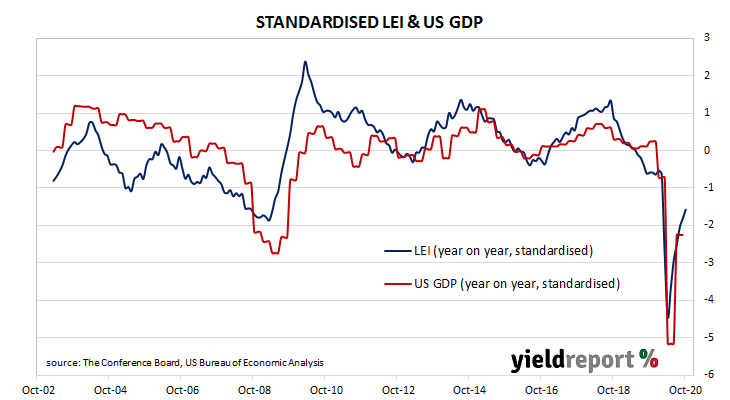Summary: US leading index increases in line with expectations in October; widespread improvements despite some weakness; Conference Board forecasts for December quarter “unlikely to exceed” 2.2% annualised; suggests growth will “moderate significantly” in final months of 2020.
The Conference Board Leading Economic Index (LEI) is a composite index composed of ten sub-indices which are thought to be sensitive to changes in the US economy. The Conference Board describes it as an index which attempts to signal growth peaks and troughs; turning points in the index have historically occurred prior to changes in aggregate economic activity. Readings from March and April signalled “a deep US recession”; more recent readings indicated the US recovery is still underway, albeit at a slowing pace.
The latest reading of the LEI indicates it rose by 0.7% in October. The result was in line with expectations and the same as September’s reading. On an annual basis, the LEI growth rate increased from September’s revised figure of -4.0% to -3.2%.
“The US LEI rose again in October, with widespread improvements despite weakness from housing permits and consumers’ outlook on economic conditions,” said Ataman Ozyildirim, Senior Director of Economic Research at The Conference Board.
Changes over time can be large but once they are standardised, a clearer relationship with GDP emerges. The latest reading implies a year-on-year growth rate of -0.5% in January, up from the -1.2% implied for December after revisions. The Conference Board forecasts an annualised growth rate for the December quarter which “is unlikely to exceed 2.2%”, or about 0.5% over one quarter.

US Treasury bond yields fell along the curve. By the end of the day, the 2-year yield had slipped 1bp to 16bps, the 10-year Treasury yields had decreased by 4bps to 0.83% while the 30-year yield finished 5bps lower at 1.55%.
A month ago, Ozyildirim had noted “the decelerating pace of improvement” of the index. Again, he pointed to the index’s slowing rate of gain, saying it “suggests growth will moderate significantly in the final months of 2020, slowing down from the unusually rapid pace in Q3.”

